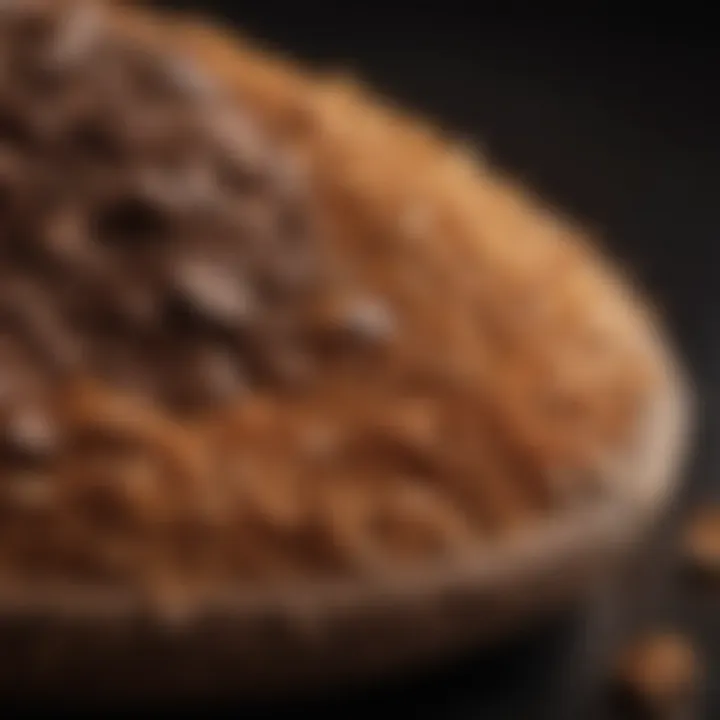Exploring Cocoa Fiber: Benefits and Applications


Intro
Cocoa fiber, derived from the processing of cocoa beans, has garnered attention in various industries due to its unique properties and health benefits. Known primarily as a by-product of chocolate production, cocoa fiber contains a substantial amount of dietary fiber, making it an appealing ingredient in health-conscious food products. This article seeks to elucidate the multifaceted uses of cocoa fiber, highlighting its significance in promoting health, enhancing nutrition, and contributing to sustainability.
Cocoa fiber is notable for its composition, which includes not only dietary fiber but also a range of bioactive compounds. These elements can potentially enhance one’s diet and overall health outcomes. Moreover, the cocoa industry’s expansion opens new pathways for the use of cocoa fiber, not only in culinary applications but also in emerging sectors such as cosmetics and environmental sustainability.
By examining the current research and trends regarding cocoa fiber, this article aims to provide a comprehensive understanding that extends beyond its traditional uses. The exploration of cocoa fiber will arm students, researchers, educators, and professionals with the knowledge necessary to appreciate its benefits and innovatory potential in modern applications.
Prelude to Cocoa Fiber
Cocoa fiber, often overlooked in discussions about cocoa products, merits attention for its remarkable versatility and numerous advantages. This article aims to delve into the complex nature of cocoa fiber, exploring its multifaceted applications and benefits. By understanding cocoa fiber's composition, we can appreciate its role in various industries, from food production to cosmetics. The exploration of cocoa fiber serves not only to highlight its health benefits but also to reveal its potential in promoting sustainability.
Definition and Origin
Cocoa fiber is a by-product derived from the processing of cocoa beans. The fiber is extracted during the production of cocoa products such as cocoa powder and cocoa butter. It consists primarily of non-digestible carbohydrates and has gained relevance for its high dietary fiber content. This fiber's origins can be traced back to ancient Mesoamerican cultures, where cocoa was first cultivated. The beans were revered not only for their flavor but also for their perceived health properties.
Historical Context
The historical narrative of cocoa fiber is closely linked with the broader history of cocoa consumption. Its journey begins with the Olmecs, who were among the first to cultivate cocoa about 3,000 years ago. Cocoa beans became integral to Mesoamerican cultures, including the Mayans and Aztecs. In these societies, cocoa was often consumed in the form of beverages and used in religious rituals. However, it wasn't until the industrial revolution that cocoa processing methods advanced, leading to the creation of various cocoa products, including the fiber we recognize today. The modern appreciation for dietary fiber, alongside rising health consciousness, has led to a renewed interest in cocoa fiber as a health-promoting ingredient.
Composition of Cocoa Fiber
Cocoa fiber is increasingly recognized for its rich composition and diverse applications. Understanding the composition of cocoa fiber is fundamental, as it provides insights into its nutritional benefits, functional properties, and its relevance in various industries. This knowledge is essential for anyone interested in health, nutrition, and sustainability.
Nutritional Profile
The nutritional profile of cocoa fiber reveals a substantial concentration of dietary fiber, which is critical for digestive health. Cocoa fiber contains both soluble and insoluble fibers.
- Soluble Fiber: This type of fiber helps in regulating blood sugar levels and lowering cholesterol. It can also support a healthy gut microbiome.
- Insoluble Fiber: It assists in promoting regular bowel movements and preventing constipation.
In addition to fiber, cocoa fiber contains important vitamins and minerals. For example, it is a source of magnesium and iron. These nutrients play a crucial role in energy production and overall metabolic processes. Inclusion of cocoa fiber in the diet can enhance the food's fiber content, making it beneficial for many who are looking to increase their intake of fiber-rich foods.
Physical and Chemical Properties
Understanding the physical and chemical properties of cocoa fiber is just as vital as assessing its nutritional benefits.
- Texture: Cocoa fiber has a granular texture, which contributes to its functionality in food products. The fine particles can enhance the mouthfeel without altering the taste.
- Water Absorption: Cocoa fiber has a high capacity to absorb water, which can improve formulation stability in food products and contribute to a desirable texture in baked goods.
- Chemical Stability: It also has considerable chemical stability, making it a favorable addition to various food formulations. This allows the fiber to maintain its qualities even during processing and storage.
Cocoa fiber can be used in products ranging from cereals to snack bars. The unique composition not only adds health benefits but also serves practical applications in food technology.
Understanding the composition of cocoa fiber is essential for its effective use in food products and health supplements. Its rich nutrient profile and functional properties make it a valuable ingredient.
Incorporating cocoa fiber into consumers’ diets can lead to more healthful choices, appealing to those who prioritize nutrition and wellness.
Cocoa Fiber in Food Industry
Cocoa fiber plays a significant role in the food industry, primarily due to its unique properties and health benefits. As a by-product of cocoa processing, cocoa fiber is often overlooked. However, its incorporation into various food products can enhance both nutritional value and consumer appeal. The food industry is increasingly leaning towards healthier options, and cocoa fiber fulfills this demand by contributing dietary fiber and functional benefits. Its application extends across different sectors, from health foods to traditional baked goods, thereby attracting a diverse range of consumers.
Usage in Functional Foods
Functional foods are products that have a positive impact on health beyond basic nutrition. Cocoa fiber fits perfectly into this category. It is rich in dietary fiber, providing both soluble and insoluble components that aid in digestive health. The incorporation of cocoa fiber into functional foods can contribute to improved gut health, as it helps in maintaining regular bowel movements and reducing constipation.


Moreover, cocoa fiber can potentially lower cholesterol levels. Its soluble fiber content interacts with bile acids, leading to a reduction in cholesterol reabsorption. This can make cocoa fiber a valuable ingredient in functional food formulations aimed at heart health.
The versatility of cocoa fiber means it can be utilized in various products, such as cereal bars, protein powders, and even smoothies. These products are designed for health-conscious consumers seeking to increase their fiber intake without compromising on taste. By adding cocoa fiber, manufacturers can improve the overall nutritional profile of their offerings, enhancing their marketability in an increasingly health-oriented environment.
Role in Bakery and Confectionery
Cocoa fiber also finds extensive usage in the bakery and confectionery sectors. Its functional properties can enhance the texture and moisture retention of baked goods, leading to improved product quality. For instance, integrating cocoa fiber into bread formulations can result in a softer crumb and prolonged freshness, which is crucial for consumer satisfaction.
In bakery products like muffins, cakes, and cookies, cocoa fiber can replace portions of regular flour. Doing so not only increases fiber content but also helps in reducing overall sugar absorption due to its effects on carbohydrates in the digestive system. This can create an appealing option for those seeking lower glycemic index products.
Confectionery items, especially chocolate-based products, can also benefit from the addition of cocoa fiber. It contributes to a more appealing texture while also enhancing the health credentials of chocolate treats. As consumers become more health-conscious, the value of including cocoa fiber in sweets becomes apparent, aligning with the growing trend towards indulgent yet nutritious foods.
Overall, the role of cocoa fiber in the food industry cannot be understated. Its ability to enhance nutritional value, improve product texture, and cater to health-conscious trends makes it an essential ingredient for manufacturers aiming to innovate and meet consumer demands.
"The integration of cocoa fiber in food products signifies a fusion of health benefits with consumer enjoyment."
By recognizing the merits of cocoa fiber, industries can leverage its advantages to create products that not only satisfy taste but also contribute positively to health.
Health Benefits of Cocoa Fiber
Cocoa fiber presents a myriad of health benefits that play a significant role in dietary habits and overall well-being. Understanding these benefits can inform personal choices regarding nutrition and health supplementation. Cocoa fiber is abundant in dietary fiber, which is essential for several bodily functions. Its integration into a balanced diet offers unique advantages that can be beneficial for a wide audience, including students, researchers, and healthcare professionals.
Impact on Digestive Health
Cocoa fiber is rich in soluble and insoluble fibers, which are essential for maintaining good digestive health. The soluble fiber improves gut health by enhancing the growth of beneficial gut bacteria. This microflora balance can lead to better digestion and nutrient absorption. On the other hand, insoluble fiber adds bulk to the stool and promotes regular bowel movements, helping to prevent constipation.
The fermentation process of cocoa fiber in the colon produces short-chain fatty acids, which have protective effects on colon health. These acids encourage the maintenance of the gut lining and can even reduce the risk of certain gastrointestinal disorders. Therefore, incorporating cocoa fiber into meals can provide a significant uplift in digestive functions.
Contribution to Weight Management
Cocoa fiber serves as an effective aid in weight management strategies. It enhances satiety, the feeling of fullness after meals, due to its high fiber content. When consumed, cocoa fiber expands in the stomach, signaling the body that it has received sufficient nutrition. This can lead to reduced overall calorie intake.
Additionally, cocoa fiber has a relatively low glycemic index. It does not cause sharp spikes in blood sugar, which is crucial for maintaining energy levels and managing hunger. It can be particularly useful for individuals looking to manage their weight more effectively. Integrating cocoa fiber in diets can facilitate a healthier eating pattern that aids in achieving weight management goals.
Potential Cardiovascular Benefits
The cardiovascular advantages of cocoa fiber are gaining attention in health research. It is associated with improved heart health due to its potential to lower cholesterol levels. Cocoa fiber might contribute to reducing low-density lipoprotein (LDL), often referred to as "bad" cholesterol. This reduction can decrease the risk of heart disease and stroke.
Moreover, the antioxidants found in cocoa fiber can aid in combating oxidative stress, a contributor to cardiovascular issues. By including cocoa fiber in a diet, individuals may find a reduction in hypertension and an improvement in overall vascular health. This aligns well with medical advice that emphasizes dietary fiber's importance in promoting heart health.
"Incorporating cocoa fiber into daily intake not only enhances digestion but also promotes effective weight management and supports heart health."
In summary, cocoa fiber's health benefits are multifaceted. From its significant role in digestive health to its promising contributions towards weight management and cardiovascular well-being, cocoa fiber emerges as a vital component in dietary considerations. Its integration can empower individuals to pursue healthier lifestyle choices.
Cocoa Fiber as a Dietary Supplement
Cocoa fiber has emerged as a noteworthy dietary supplement in recent years, garnering attention for its unique health benefits and nutritional properties. As a non-digestible carbohydrate with significant fiber content, cocoa fiber promotes gut health, aids digestion, and contributes to a feeling of fullness. These attributes position cocoa fiber as a viable alternative to other common dietary fibers, especially for individuals seeking to enhance their fiber intake without altering their diet significantly.
The addition of cocoa fiber into various forms of supplements allows consumers to experience its health benefits easily. Understanding the forms and formats available, along with the recommended dosages and usages, is crucial for maximizing the benefits of cocoa fiber supplements.
Forms and Formats Available
Cocoa fiber can be found in several forms that cater to different consumer preferences. The most common formats include:


- Powder: Cocoa fiber powder is perhaps the most versatile form. It can be easily mixed into smoothies, baked goods, or cereals. This format retains most of its nutrients and fiber properties, making it an convenient option for daily use.
- Capsules: For those who prefer not to alter their meals, cocoa fiber is available in capsule form. Each capsule contains a concentrated dose, offering an easy way to supplement daily fiber intake without the need for consuming food products.
- Bars: Some health bars incorporate cocoa fiber as an ingredient. This format provides a portable option and combines cocoa fiber with other nutrients, making for an easy snack.
Consumers should consider their lifestyle, dietary habits, and personal preferences when selecting the form that best suits their needs. Each format offers unique advantages and can be incorporated into various dietary regimens.
Recommended Dosage and Usage
The recommended dosage of cocoa fiber supplements varies based on the form and individual health requirements. Generally, guidance suggests:
- For powder: A common suggestion is to start with 5 to 10 grams per day. Users can gradually increase this amount as their body adapts, depending on personal digestive tolerance.
- For capsules: Typically, one to two capsules per day is recommended. It is wise to follow specific directions on the product label to ensure safe and effective usage.
- For bars: They should be consumed in moderation, no more than one or two per day, considering the overall dietary fiber intake from all sources.
It's critical to drink adequate water when increasing fiber intake to support proper digestion and prevent discomfort. As with any supplement, consulting with a healthcare provider is advisable before starting any new regimen, especially for individuals with pre-existing health conditions.
Incorporating cocoa fiber into a balanced diet can yield numerous health benefits, notably improved digestive health and enhanced satiety.
Environmental Impact of Cocoa Fiber
The environmental impact of cocoa fiber is significant in several ways, particularly concerning sustainability and resource management. Cocoa is a vital agricultural product, and its processing can lead to considerable waste. The incorporation of cocoa fiber into various applications addresses not only the efficiency of resource utilization but also aligns with current sustainability goals. By diverting waste from landfills, the cocoa industry can enhance its sustainability profile while creating new opportunities for innovation.
Sustainability in Cocoa Production
Sustainability in cocoa production involves practices that ensure the long-term health of ecosystems while providing economic benefits to farmers. Cocoa fiber is a byproduct that emerges from the processing of cocoa beans. Its utilization contributes to a circular economy model within the cocoa industry. Farmers and producers often face pressure to maximize profits, which can lead to deforestation and other environmentally harmful practices. By finding value in cocoa fiber, the industry promotes sustainable practices that help preserve forests and biodiversity.
Furthermore, implementing sustainable agricultural practices, such as agroforestry and organic farming, creates a flourishing environment for cocoa cultivation. Supporting these methods can mitigate the negative impact of cocoa production on the environment while ensuring better-quality fiber. These strategies not only serve the environment but also provide farmers with a more resilient and potentially profitable product.
Waste Reduction Strategies
Waste reduction strategies are essential in the cocoa industry as they help minimize the byproducts generated during cocoa processing. Cocoa fiber can be viewed as a valuable resource rather than simply waste. Collecting and processing cocoa fiber for various applications can create a more sustainable production cycle. Here are a few strategies that can be employed:
- Utilization in Snacks and Health Foods: Cocoa fiber can be employed in the formulation of snacks and health foods, providing rich dietary fiber without adding unnecessary calories.
- Incorporation in Animal Feed: Sustainable feeding solutions can utilize cocoa fiber as a nutritious element for livestock, thus reducing waste generated by cocoa processing.
- Biodegradable Packaging Materials: Innovations in packaging can leverage cocoa fiber's biodegradable characteristics, providing an eco-friendly alternative to traditional plastics.
By integrating these waste reduction strategies, the cocoa industry can significantly diminish its environmental footprint. These practices resonate well with a global audience increasingly concerned about sustainability and eco-friendly consumption.
Cocoa fiber epitomizes the potential of by-products in creating a sustainable future for agriculture.
Cocoa Fiber in Cosmetics and Personal Care
Cocoa fiber, often underestimated, offers important applications in the cosmetics and personal care sectors. Given its origin, as a by-product of cocoa processing, the presence of bioactive compounds makes cocoa fiber an appealing ingredient for developing skincare products. The demand for natural and sustainable ingredients in cosmetics has grown in recent years. Thus, cocoa fiber's multifaceted properties commend it in various formulations for enhancing skin texture and overall health.
Exfoliating Properties
Cocoa fiber is notable for its excellent exfoliating properties. It gently removes dead skin cells without causing irritation. This quality makes it suitable for products such as scrubs and cleansers. Natural exfoliants are preferred over microbeads due to environmental concerns. The use of cocoa fiber contributes to more sustainable cosmetic production.
Adding cocoa fiber to skincare products might enhance their efficacy. When applied, it creates a mild abrasive texture. Furthermore, its organic origin appeals to consumers looking for eco-friendly options.
Cocoa fiber can be a natural alternative to synthetic exfoliants, aligning with the growing trend towards environmentally friendly beauty solutions.
Moisturizing Benefits
Cocoa fiber also provides significant moisturizing benefits. It has a unique ability to maintain skin hydration levels. When integrated into cosmetic formulations, it can enhance the skin's natural moisture barrier. This aspect is particularly beneficial for individuals with dry or sensitive skin.
The structural composition of cocoa fiber allows it to trap moisture effectively. This leads to soft and supple skin upon application. Many brands utilize cocoa fiber in lotions and creams. The result is a product that nourishes without feeling greasy.
Research Trends in Cocoa Fiber Studies


Research in cocoa fiber studies has been gaining attention due to its various applications in health, nutrition, and sustainability. The study of cocoa fiber expands beyond its basic composition and health benefits. It integrates topics like consumer behavior, technology innovations, and environmental concerns that are increasingly relevant in today’s society.
As researchers delve into the properties and potential uses of cocoa fiber, they are not only exploring its dietary advantages but also how it fits within broader trends such as plant-based diets and sustainable agriculture. This multidisciplinary approach enhances our understanding of how cocoa fiber can be utilized more effectively in different industries.
Current Research Focus Areas
Recent studies have highlighted several focus areas in cocoa fiber research. These may include:
- Nutritional Enhancement: Studies investigate how cocoa fiber can enhance the nutritional profile of various food products. This includes its ability to improve fiber content, aid in digestion, and lower blood sugar levels.
- Functional Ingredients: Researchers are looking into cocoa fiber’s role as a functional ingredient in food science. It may affect texture, flavor absorption, and shelf-life stability of baked goods and snack foods.
- Health Claims Validity: Clinical research is assessing the veracity of health claims associated with cocoa fiber consumption. Trials focus on its impact on weight management, satiety, and general well-being.
- Environmental Sustainability: As the world shifts toward sustainable practices, researchers are examining the ecological aspects of cocoa fiber production. This includes its ability to reduce waste in cocoa processing and its role in circular economy strategies.
Exploring these areas aids in pinpointing the effectiveness of cocoa fiber in various sectors while addressing the needs of consumers and industries focused on nutrition and sustainability.
Innovative Uses and Future Directions
The future of cocoa fiber appears promising. Innovations in processing technology may allow for better extraction and utilization of cocoa fiber from cocoa shells. Potential areas of exploration include:
- Cosmetic Applications: With increasing consumer interest in natural ingredients, cocoa fiber is being examined for its functionality in cosmetics. Its exfoliating properties can be valuable in skin care products, enhancing the market for eco-friendly beauty items.
- Food Fortification: The trend of fortifying food products with dietary fiber opens new avenues for cocoa fiber. Its unique properties could lead to products that are marketed towards health-conscious individuals.
- Bioactive Compounds: Future studies might focus on identifying bioactive compounds within cocoa fiber that contribute to health benefits, potentially revolutionizing food products.
Research continues to uncover the multifaceted role of cocoa fiber, revealing its potential as an ingredient that supports health, sustainability, and market demands.
The trajectory of cocoa fiber research emphasizes the need for ongoing studies and innovations. As industries adapt to the demands of consumers and environmental challenges, cocoa fiber remains a significant contributor. It has the potential not only to enhance food products but also to engage consumers in a sustainable future.
Regulatory Considerations
Regulatory considerations play a crucial role in the commercial usage of cocoa fiber, especially as the demand for natural and functional food ingredients increases. Understanding these guidelines ensures that cocoa fiber products are safe for consumers and meet quality standards. Both the Food and Drug Administration (FDA) in the United States and international regulatory bodies set forth requirements that influence how cocoa fiber is processed, marketed, and sold.
Effective regulation fosters trust among consumers and encourages manufacturers to adhere to safety protocols. Furthermore, clear regulatory frameworks contribute to sustainable practices in cocoa production, which is essential for preserving environmental integrity while promoting public health.
Food and Drug Administration Guidelines
The FDA has established specific guidelines that govern food ingredients, including cocoa fiber. These guidelines are designed to protect consumer health by ensuring that products are safe for consumption and properly labeled. Cocoa fiber falls under the category of dietary fibers, which requires a thorough understanding of its nutritional profiles, such as caloric content and health benefits.
Key elements of these guidelines include:
- Safety Assessments: Before cocoa fiber can be marketed, it must undergo rigorous safety evaluations to determine any potential health risks.
- Labeling Requirements: The FDA mandates accurate labeling. This includes specifying the amount of dietary fiber per serving, which is important for consumers who track their fiber intake.
- Health Claims: Any assertions made regarding health benefits must be backed by scientific evidence. Claims related to digestion, heart health, and weight management often require approval.
These FDA guidelines help ensure that cocoa fiber products are both effective and safe, providing consumers with confidence in their dietary choices.
International Standards and Compliance
International standards are critical for products that cross borders. Bodies such as the Codex Alimentarius Commission set forth guidelines that align different country regulations. Compliance with these standards is essential for cocoa fiber to be accepted in global markets.
Consider these factors:
- Global Trade: Adhering to international standards facilitates trade by ensuring that products meet safety and quality requirements across different regions.
- Harmonization of Regulations: Compliance with international guidelines helps create consistency, reducing barriers for manufacturers wanting to enter new markets.
- Sustainability: Many international regulations also emphasize sustainable practices in production, which benefits both the environment and local communities involved in cocoa farming.
The implications of these regulatory frameworks are wide-reaching. As cocoa fiber gains prominence in various sectors, staying informed about these regulations is vital for producers and consumers alike. Regulatory considerations not only guide the industry towards safer practices but also pave the way for innovative uses in the future.
Ending
The conclusion of this article is vital as it synthesizes the wealth of information regarding cocoa fiber. Understanding the significance of cocoa fiber extends beyond its basic definition; it encompasses its role in various industries, health benefits, and environmental impacts.
Summary of Cocoa Fiber's Significance
Cocoa fiber stands out as a valuable resource derived from cocoa processing. With its high fiber content, it contributes significantly to digestive health. Many studies have pointed out that dietary fibers like those in cocoa fiber can reduce the risk of certain diseases. Additionally, in the food industry, cocoa fiber is a remarkable ingredient used to enhance the nutritional profile of products. Its incorporation in functional foods can improve satiety and promote overall health, making it a favorite among nutritionists and food developers alike. Moreover, the environmental advantages of using cocoa fiber cannot be ignored; it aids in waste reduction and promotes sustainability by utilizing by-products that otherwise may go to waste.
Future Perspectives
Looking ahead, the potential for cocoa fiber is expansive. Research continues to explore innovative applications, particularly in areas like health supplements and cosmetics. As consumers become increasingly aware of health and sustainability, cocoa fiber's demand could rise dramatically. Its ability to meet the growing preference for fiber-rich diets positions it well for the future. Furthermore, advances in food technology may open new avenues for its use, possibly leading to enhanced formulations that leverage its functional properties. Regulatory bodies may also adapt to these changes, ensuring that cocoa fiber as a product remains safe and beneficial for diverse applications.







